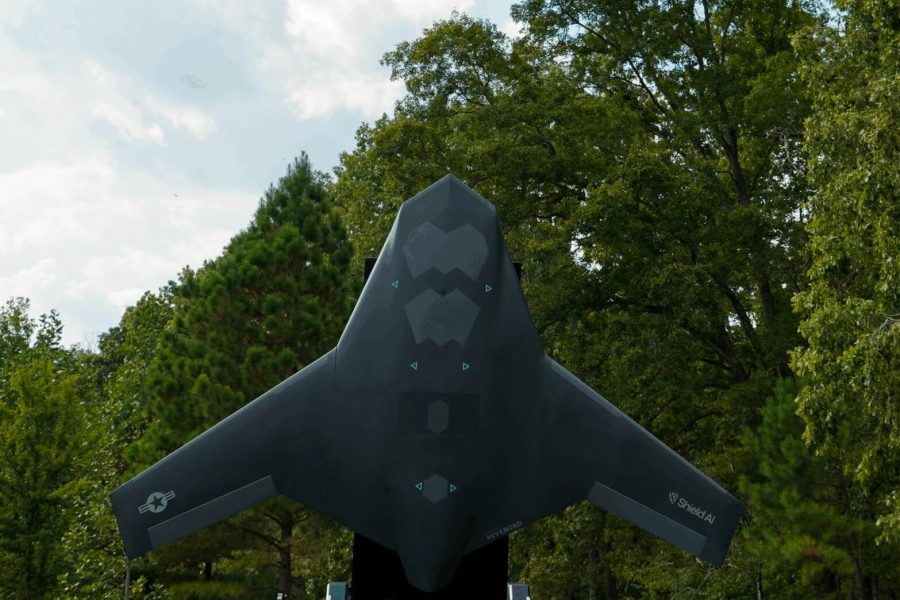Shield AI has entered the increasingly crowded field of Collaborative Combat Aircraft, this week announcing its “X-BAT” vehicle that stands out from others by having both vertical takeoff and landing capability and supersonic speed.
The X-BAT, with a cranked-arrow shape the company says is stealthy, is also “the only platform in its class to combine VTOL with a range of [greater than] 2,000 nautical miles with full mission payload,” allowing it to operate from “ships, islands and austere sites,” according to a company announcement.
Shield AI touts the X-BAT as being a 4G airplane with a 50,000 foot ceiling. With a 2,000-mile range, the company says X-BAT would have a 1,000-nautical mile combat radius.
The Air Force has been developing CCAs for several years now—semi-autonomous drones meant to fly alongside manned fighters into combat. The service has selected Anduril and General Atomics to compete for the airframe portion of “Increment 1” of the program.
Asked if Shield AI is planning to compete for Increment 2, still in development, Senior Vice President of Aircraft Engineering Armor Harris said that the company “began customer engagements earlier this year and they are going very well. We can’t say anything other than that.”
Besides the Air Force, both the Army and Navy have expressed varying levels of interest in CCAs. Other countries like Australia, the Netherlands, and the United Kingdom, are also exploring the concept.
“At the core of X-BAT is Hivemind, Shield AI’s AI-enabled autonomy software built for GPS- and comms-denied environments, allowing X-BAT to penetrate contested battlespace, team with manned aircraft, and execute collaborative tactics without constant comms,” the company said. The General Atomics’ CCA entry, the YFQ-44A, also uses the Hivemind system.
The company also has some drone experience with the much-smaller V-BAT, which has been used in Ukraine.
Shield AI is in discussions with various potential partners for production of the X-BAT airframe and propulsion system and expects to announce those partnerships in the coming weeks. A first flight using the VTOL system is expected next year, and an all-up demonstration is targeted for 2028.
With supersonic speed, the X-BAT would be able to keep up with crewed fighters, a capability lacking among the raft of new CCA entrants in recent months. While those other aircraft are all using variations of business jet engines, the X-BAT would use either a Pratt & Whitney F100 or GE Aerospace F110 engine; the same powerplants used on F-15 and F-16 fighters. Shield did not say whether it plans to source the engines new or from old stock in storage, but company officials have said the engine will be fitted with a proven 3-D, thrust-vectoring nozzle, both to aid its maneuverability and enable its tail-sitter landing system.
Besides speed, using a fighter-class engine will provide “reliability, maintainability, and logistics maturity,” Shield AI said.
The cost of the X-BAT is to be about $27 million; right around what the Air Force originally said it expected a CCA to cost, although Air Force Secretary Troy Meink has recently said he would like CCAs at a substantially lower price point.
The X-BAT could be well-suited to the Air Force’s Agile Combat Employment model, which calls for small units operating from widely dispersed and potentially austere locations, moving frequently to complicate adversary targeting by long range surface-to-surface and air-to-surface missiles. Being runway-independent means the craft can launch and recover from places not normally associated with air operations.
In making the announcement, Shield AI president and co-founder Brandon Tseng said that “airpower without runways is the holy grail of deterrence. It gives our forces persistence, reach, and survivability, and it buys diplomacy another day.” He called the aircraft “transformative” because of its differentiating characteristics.
Shield AI is touting the X-BAT as able to handle “strike, counter-air, electronic attack, [intelligence, surveillance and reconnaissance] missions, and more. The company said it will be “affordable and attritable, built to deliver fighter-class performance at an order of magnitude lower acquisition and lifecycle cost than fifth-generation jets.”
Besides stealth and autonomy, the aircraft will employ “adaptive tactics” to ensure its survivability. Its autonomy will also permit it to keep operating “in denied, degraded, and comms-limited conditions,” the company said. The aircraft is to have an open architecture and the AI onboard is “platform agnostic” to integrate with current and future concepts.
Launched and recovered vertically on a trailer, the X-BAT has a 39-foot wingspan and a length of 26 feet, putting it in the same size class as an F-5 fighter. Animated videos showing the concept in action show it possibly carrying the AIM-120 AMRAAM missile and the Navy’s new AIM-174B “Gunslinger” very long range air-to-air missile, based on the Standard Missile-6. Artwork on Shield AI’s website shows the CCA with a wide range of small munitions. External carriage of some munitions is also possible.
Company officials said they expect to build multiple launch-and-recovery trailers for each aircraft, to multiply the places where the X-BAT can land and subsequently fly again.
X-BAT is just the latest CCA concept to break cover recently. Last month, Lockheed Martin unveiled its subsonic “Vectis” stealth drone, and Lockheed’s Sikorsky unit recently unveiled the rotor-propelled “Nomad” vertical takeoff/landing CCA family, ranging from a wingspan of 10 to 55 feet, and aimed at missions ranging from logistics support to kinetic attack.


